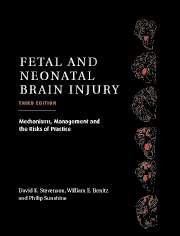Book contents
- Frontmatter
- Contents
- List of contributors
- Foreword
- Preface
- Part I Epidemiology, Pathophysiology, and Pathogenesis of Fetal and Neonatal Brain Injury
- Part II Pregnancy, Labor, and Delivery Complications Causing Brain Injury
- Part III Diagnosis of the Infant with Asphyxia
- 20 Clinical manifestations of hypoxic–ischemic encephalopathy
- 21 The use of the EEG in assessing acute and chronic brain damage in the newborn
- 22 Structural and functional imaging of hypoxic–ischemic injury (HII) in the fetal and neonatal brain
- 23 Near-infrared spectroscopy and imaging
- 24 Placental pathology and the etiology of fetal and neonatal brain injury
- 25 Correlations of clinical, laboratory, imaging and placental findings as to the timing of asphyxial events
- Part IV Specific Conditions Associated with Fetal and Neonatal Brain Injury
- Part V Management of the Depressed or Neurologically Dysfunctional Neonate
- Part VI Assessing the Outcome of the Asphyxiated Infant
- Index
- Plate section
21 - The use of the EEG in assessing acute and chronic brain damage in the newborn
from Part III - Diagnosis of the Infant with Asphyxia
Published online by Cambridge University Press: 10 November 2010
- Frontmatter
- Contents
- List of contributors
- Foreword
- Preface
- Part I Epidemiology, Pathophysiology, and Pathogenesis of Fetal and Neonatal Brain Injury
- Part II Pregnancy, Labor, and Delivery Complications Causing Brain Injury
- Part III Diagnosis of the Infant with Asphyxia
- 20 Clinical manifestations of hypoxic–ischemic encephalopathy
- 21 The use of the EEG in assessing acute and chronic brain damage in the newborn
- 22 Structural and functional imaging of hypoxic–ischemic injury (HII) in the fetal and neonatal brain
- 23 Near-infrared spectroscopy and imaging
- 24 Placental pathology and the etiology of fetal and neonatal brain injury
- 25 Correlations of clinical, laboratory, imaging and placental findings as to the timing of asphyxial events
- Part IV Specific Conditions Associated with Fetal and Neonatal Brain Injury
- Part V Management of the Depressed or Neurologically Dysfunctional Neonate
- Part VI Assessing the Outcome of the Asphyxiated Infant
- Index
- Plate section
Summary
Introduction
The goal of this chapter is to help the reader understand the fundamentals of neonatal electroencephalogram (EEG), including the source of EEG signals and the technical aspects of a well-performed EEG. Particular attention will be paid to: (1) maturational features which correlate with the infant's conceptional age; (2) abnormal findings indicative of encephalopathies of various causes; and (3) value of the EEG in determining the prognosis for normal and abnormal neurological outcome. The role of EEG in neonatal seizures is covered more thoroughly in Chapter 37.
Value of the EEG
The EEG is a valuable tool for assessing neonatal brain function. It has unique properties compared to many other diagnostic tests of brain function. For example, it can resolve temporal aspects of brain function more effectively than computed tomography (CT), magnetic resonance imaging (MRI), or even the bedside neurological examination. There is no other test that can so precisely discriminate between epileptic seizures and nonepileptic events in the neonate. It provides information about the severity of brain dysfunction (encephalopathy). Serial EEGs provide information about the course and effectiveness of treatment. Sometimes the EEG helps distinguish between various etiologies of encephalopathy as well.
Indication for EEG
An EEG in the neonate should be considered when questions arise regarding the cause of the child's abnormal neurological responses. There are many scenarios in which the EEG provides much needed information that is otherwise difficult or impossible to obtain.
- Type
- Chapter
- Information
- Fetal and Neonatal Brain InjuryMechanisms, Management and the Risks of Practice, pp. 425 - 445Publisher: Cambridge University PressPrint publication year: 2003



